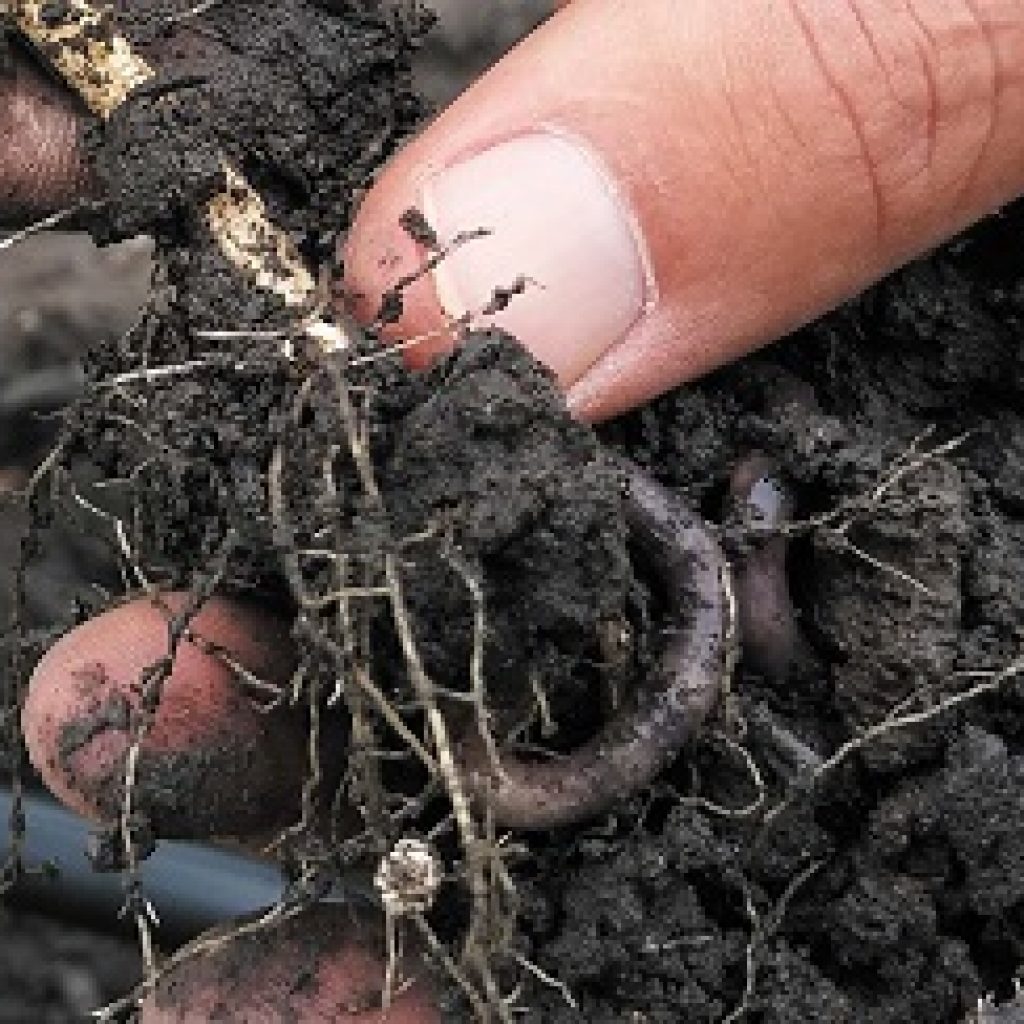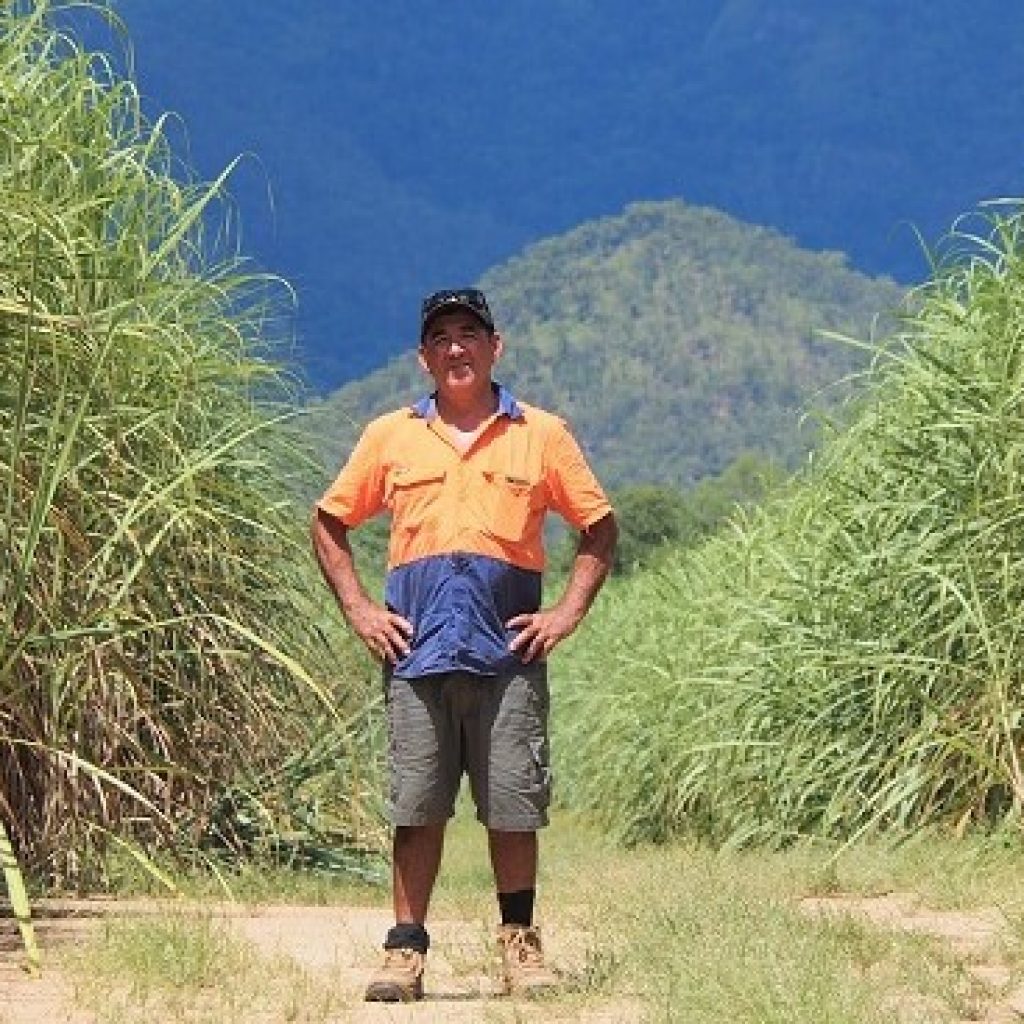IMPROVING SOIL HEALTH
ROLLER CRIMPER, STRIP TILLAGE FOR SOIL HEALTH
2 MARCH 2022
It began at a soil health field day – and now Kairi farmers Alex and Alicia Bertola are on a roll.
The cane, maize and peanut producers have swapped their ripper for a roller crimper and bare earth for mixed cover crops as they explore different ways to improve soils and reduce fertiliser inputs.
Cover crops
The Bertolas planted their first cover crop in August – of field peas, tillage radish, vetch, oats and rye – after harvesting peanuts. They followed up with a roller crimper in late September, laying the crop flat and crimping stems to stop the plants from growing to create a mat of organic matter for weed control and moisture retention.
“We strip-tilled in January and planted corn straight into what was left of the cover crop,’’ Alicia said. “The corn is coming up now and it’s looking good.”
The Bertolas are working with Terrain NRM to trial these methods in four hectares of their corn crop and one hectare of peanuts, and the farm will be used as a demonstration site through Terrain’s Digging Deeper soil health program.
Farming more sustainably
Alicia said a desire to farm more sustainably was behind the changes, which also include trials of worm casting juice and seaweed extract.
“We want to build up organic matter and drop fertiliser costs – we’re right at the beginning of our journey so there’s a lot to learn,’’ she said. “The goal is to gradually decrease fertiliser usage over a number of years and to see the same yields or, even if they’re less, the same profits given a reduction in input costs.”
Machinery passes halved
Changes to ground preparation methods have halved the number of machinery passes.
“We normally plough, rip and/or disc our paddocks depending on what we are planting. With this system we use the roller crimper, then the strip tiller. Ideally that’s it. That’s what we’ve done for the corn trials. With the strip tillage equipment, it also means we are now leaving two thirds of the land in this trial paddock undisturbed and largely uncompacted.
“It’s a learn as we go process. Next time we’ll shorten the amount of time between planting the cover crop and the new crop going in because the blanket didn’t last quite long enough and some of the cover crop had time to seed and re-grow. We’d also like to try a cash crop as a cover crop.
“With the peanuts it’s a bit different too. Being a low-growing plant that you dig up, we’re seeing what we can do to make it work. This time around we had to spray for weeds, but next time we’ll trial getting the peanuts in as soon as possible after roller crimping. Hopefully the trash will stop the weeds long enough for the peanuts to emerge and fill in the rows.
“In the corn we also trialled a neighbour’s cows in part of the trial paddock, as a way of terminating the cover crop while adding microbes through their dung.”
Trials in the Wet Tropics
Terrain NRM agronomist Sally Fields said crimp rollers and strip tillage had been trialled in the Wet Tropics before, largely in the cane industry, but hadn’t been used widely in broadacre crops.
“There is good application potential on the Tablelands, with its fertile soils, high rainfalls and differing micro-climates,’’ she said.
“It’s a big step for farmers so it’s great to see landholders like Alicia and Alex making changes after going to local regenerative farming workshops, doing their own research and talking to others who are pushing the window for better results on tired soils.
Planting corn into strip-tilled, roller-crimped ground.

“Strip tillers and roller crimpers are part of the tool kit available for building the health of your soil and, in turn, building the nutrient density of the crops grown.
“It’s not a one size fits all thing – it’s about adapting methods to suit your individual farm. The goal in the long run is less overheads and better outcomes for growers and for the land.”
The Digging Deeper Soil Health program is supported by Terrain NRM through funding from the Australian Government’s National Landcare Program.
For more information about transitioning to a regenerative farming system, call Terrain NRM agronomist Sally Fields on 0421 710 474.
FAST FACTS
About roller crimpers:
What are they? Water-filled drums with Chevron-patterned blades that attach to the front or back linkage of a tractor.
What do they do? Crimpers knock down cover crops, crimping the stems in several places, stopping the sap flow and forming a mulch matt to suffocate weeds. The crimped crop can then be planted directly into with the following cash crop.
What are the benefits? Less erosion, weed pressure, cost and labour. Improved soil health, organic matter, biodiversity.
Cover crop selection for roller crimping:
Remember that diversity is key – select a minimum of four family groups.
Aim for rates of 25-30kg/ha
Choose single tillering annuals specific to the season of growth e.g. buckwheat, millet, sunn hemp, hairy vetch, oats, rye corn, cow pea, tillage radish, butterfly pea
Avoid planting forage sorghum, Rhodes grass and the likes. These are persisting perennials/annuals that tiller from the base of the plant and don’t result in termination from crimping
Choose appropriate seeds for the season. There are summer and winter varieties e.g. rye corn (winter), millet (summer/winter, sunn hemp (summer).
Select untreated seeds because fungicides kill soil microbes
Seed mix selection depends on the constraints of your soil and what you are aiming to improve.
As a general rule aim for mixes of: 60-65% cereal and grasses (e.g. millet, rye corn, oats, barley), 20-25% legumes (e.g sunn hemp, cowpea, butterfly pea, lab lab), 5-10% sunflowers, <2% brassicas (e.g forage brassicas, canola, daikon radish, kale) and 1% chenopods (e.g. spinach, swiss chard).
RELATED NEWS
Mulch trials: Which types work best?
 Elaine
Elaine
 February 27, 2024
February 27, 2024
New soil health project
 Elaine
Elaine
 September 22, 2023
September 22, 2023
Finding the ‘sweet spot’ for fertiliser
 Elaine
Elaine
 August 17, 2023
August 17, 2023






























